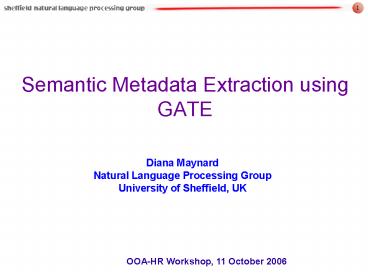Semantic Metadata Extraction using GATE PowerPoint PPT Presentation
1 / 12
Title: Semantic Metadata Extraction using GATE
1
Semantic Metadata Extraction using GATE
- Diana Maynard
- Natural Language Processing Group
- University of Sheffield, UK
2
h-TechSight project
- Integration of a variety of next generation
knowledge management technologies, in the domain
of chemical engineering. - Knowledge Management Portal enables support for
knowledge intensive industries in monitoring
information resources on the Web - observe information resources automatically on
the internet - notify users about changes occurring in their
domain of interest. - Much effort in terms of knowledge management has
been placed in the area of employment because it
affects every organisation and business - Monitoring job advertisements over time can alert
users to changes such as requirements for skills,
general trends in the field, comparison of
salaries, etc.
3
An Architecture for Language Engineering
- GATE is used to enable the ontology-based
semantic annotation of web-mined documents - Instances in the text are linked with concepts in
the ontology - Performs analysis of unrestricted text to extract
from the text instances of concepts in the
ontologies - Instances linked to the ontology are exported to
a database, enabling monitoring of such instances
and concepts over time, according to the users
interests
4
Gate IE system
- Architecture consists of a pipeline of processing
resources which run in series - Many of these processing resources are language
and domain-independent - Pre-processing stages include
- word tokenization
- sentence splitting
- part-of-speech tagging
- Main processing is carried out
- by a gazetteer linked to one nor more ontologies
- by a set of grammar rules
5
Demo Employment ontology
- Demo Employment ontology has 9 Concepts
Location, Organisation, Sectors, JobTitle,
Salary, Expertise, Person and Skill - Each concept in the ontology has a set of
gazetteer lists associated with it, which help
identify instances in the text - default lists - quite large and contain common
entities such as first names of persons,
locations, abbreviations etc. - domain-specific lists - need to be created from
scratch. - keyword lists - collected for recognition
purposes to assist contextually-based rules,
also attached to the ontology, because they
clearly show the class to which the identified
entity belongs. - Lists can be acquired automatically from the web
or from training data
6
Populated ontology
- Lists are linked directly to an ontology, such
that instances found in the text can then be
related back to the ontology
7
Visualisation of Results
- Implemented as a web service.
- User selects a URL and the concepts in which
he/she is interested
- System performs the analysis
- User can view analysis in different ways
URL Site Declaration Area
Concept Selection Area
8
Visualisation of Results
A new web page is created with highlighted
annotations
9
Database Output
The occurrences of the instances over time are
stored dynamically in a database
10
Dynamics of Concepts
- Users may see tabular results of statistical data
about how many annotations each concept had in
the previous months, as well as seeing the
progress of each instance in previous time
intervals
Click a Concept to see Dynamics of its Instances
11
Dynamics of Instances
- DF is an elasticity metric that quantifies
dynamics of an instance, taking account of volume
of data and time period - Instances for the concept "Organisation" can
track the recruitment trends for different
companies.
- Monitoring instances for concepts such as Skills
and Expertise can show which kinds of skills are
becoming more or less in demand.
12
Evaluation and User feedback
- Overall, the system achieved 97 Precision and
92 Recall - Tested by real users in industry, e.g. Bayer,
JetOil, IChemE. - Found to be helpful in increasing efficiency in
acquiring knowledge and supporting project
workhelping to scan, filter, structure and store
the wealth of information - Application areas spanned from RD, engineering
and production, to marketing and management - Employment application was a valuable means of
graduates gaining a fresh insight into their jobs
and related training which may be narrower than
it ideally should due to company constraints
(i.e. time and money)

